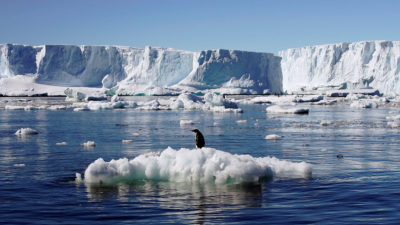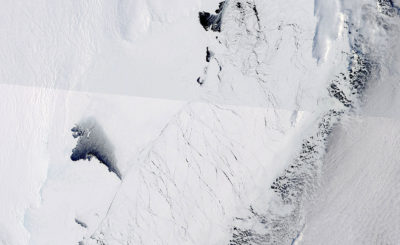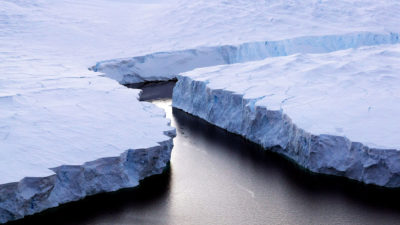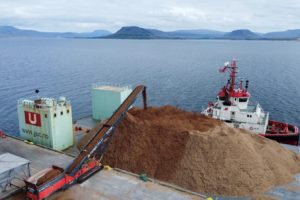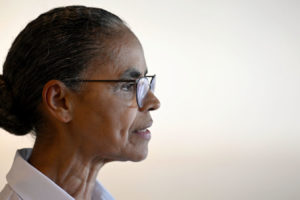No place on Earth is colder than East Antarctica. Home to the South Pole and making up two-thirds of the southernmost continent, the vast ice sheets of East Antarctica — formed over tens of millions of years — are nearly three miles thick in places. The temperature commonly hovers around -67 degrees Fahrenheit (-55 degrees Celsius); in 2010, some spots on East Antarctica’s polar plateau plunged to a record-breaking -144 degrees F.
Now, however, parts of the East Antarctic are melting.
Research into what’s happening in East Antarctica is still in its early stages. It’s hard to decipher what exactly is taking place on a gigantic continent of ice with just a few decades of satellite data and limited actual measurements of things like snowfall and ocean temperatures. But according to one controversial paper released earlier this year, East Antarctica is now, in fact, shrinking, and is already responsible for 20 percent of the continent’s ice loss.
For decades, researchers considered this portion of the continent to be stable. While warming sea and air temperatures have caused ice shelves and glaciers in the lower-altitude, warmer western regions of the Antarctic to melt and collapse, the larger, colder East had seemed an untouchable behemoth. If anything, climate change was expected to bring more snow to its interior, making its ice sheets grow in size.
The Antarctic contains about 90 percent of the planet’s ice, enough to raise global sea levels 200 feet.
But that picture is starting to change. Scientists are seeing worrying signs of ice loss in the East Antarctic. Glaciers are starting to move more quickly, dumping their ice into the Southern Ocean; in satellite images, depictions of the fast-moving ice light up in red, like a panic sign. The biggest and most obvious, the Totten Glacier, alone contains enough ice to raise global sea levels by 12.6 feet. “That’s the big red bullseye,” says Ted Scambos, a glaciologist at Colorado’s National Snow and Ice Data Center. The most recent data shows that Totten isn’t alone.
A melting East Antarctic is deeply worrying. The Antarctic as a whole contains about 90 percent of the planet’s ice — enough in theory to raise global sea levels an average of roughly 200 feet should it all melt. The eastern half is the big player in this game: it holds 10 times more ice than the West — enough, on its own, to raise sea levels by 170 feet. The full force of a melting Antarctic might not be felt for many thousands of years, but the continent could add a foot to sea level by 2100, says University of Massachusetts, Amherst geoscientist Robert DeConto, and possibly more than 3 feet by the mid-22nd century. Combined with melting mountain glaciers, the thawing Greenland Ice Sheet, and the expansion of water as it gets warmer, global sea levels could rise as much as 6 feet by the end of this century, swamping low-lying islands as well as large sections of coastline in places like Florida.
Annual ice loss in glaciers along the Wilkes Land coast in East Antarctica. The top four glaciers shown have lowered their surface height by about 9 feet since 2008. NASA Earth Observatory/Joshua Stevens
Concerns about eastern Antarctica are not that its interior plateau will soon start to melt — it’s still extremely cold and should remain so for a long while. But its edges, in contact with warming ocean waters, are another matter. As the region’s ice shelves — floating atop the Southern Ocean — erode, the vast glaciers behind them could rapidly accelerate their slide into the sea. This phenomenon occurred in 2002 when the Larsen B ice shelf famously collapsed off the Antarctic Peninsula. In the ensuing years, the glaciers behind the Larsen B, which had been held in place by the massive ice shelf, accelerated their slide to the sea by 5 to 8 times. Theoretically, if that happens continent-wide, points out Eric Rignot, a glaciologist at the University of California, Irvine, it would raise sea levels by 13 feet per century.
“You want to be scared by something?” says Rignot. “That’s the worst-case scenario. Antarctica can do that.”
The Antarctic is split into two unequal portions by the Transantarctic Mountains, a 2,200-mile-long range whose highest peaks are about half as tall as Mount Everest. The smaller area to the west, holding enough ice to raise sea levels by about 17 feet, has seen dramatic changes in recent decades. Today, satellites show huge glaciers moving rapidly toward the coast, with these wide rivers of ice sometimes moving several miles a year. “Since they’re maybe half-a-mile thick, that’s cubic miles of ice being pushed into the ocean: hundreds of billions of tons,” says Scambos. A recent review by nearly 100 polar scientists — known as the Ice Sheet Mass Balance Inter-comparison Exercise, or IMBIE — shows that from 2012 to 2017, the West Antarctic lost some 159 billion tons of ice annually, more than twice the rate of the early 2000s.
The main reason for the western half’s rapid ice loss is its topography. The bowl-shaped bedrock under its ice is mostly below sea level. As warming ocean waters lick away at the underside of the floating ice shelves, a runaway effect lifts more and more ice up and off the bedrock to where it can be melted from underneath. As the ice shelves melt and break away, the massive glaciers behind them start to flow into the sea.
At the same time, shifting wind patterns linked to climate change are driving the top layer of cold, fresh water around the Antarctic away from shore, and the bottom layer of warmer water is moving upward to take its place. While that water is still frigid, it is nevertheless warm enough to cause some serious melting in a place like Antarctica, says Scambos. “It’s 3 to 4 degrees Celsius above freezing,” he says. “That represents a tremendous amount of heat. Once that gets started, it acts as a pump to draw more warm water in.”
“Early satellite data showed something going on in East Antarctica, but I don’t think anyone took it seriously,” says one scientist.
The eastern half of the continent, by comparison, sits higher above sea level than its western cousin. The ice here is thicker and the air colder. For decades, researchers hardly bothered to look at it. “The satellite data very early on showed something going on in the East Antarctic, but I don’t think anyone took it seriously,” says Rignot. “Now that has changed.”
A few large basins in the East, including the Wilkes and Aurora sub-glacial basins, actually share the same sub-sea-bowl topography as the West. And although there are just a handful of glaciers here, their ice can be more than 6,500 feet thick. That’s a lot of vulnerable ice. “The majority of East Antarctica is in balance, and some might be gaining mass,” says Chris Stokes, a glaciologist at Durham University in England. “But it is often overlooked that just one or two of its basins hold nearly as much ice as the West Antarctic.”
The Totten Glacier — that big red bullseye in the satellite maps — is flowing faster today than in 2000. Catherine Walker at NASA’s Jet Propulsion Laboratory in California has seen rapid outflows not just at Totten, but also at four much smaller glaciers in a region known as Vincennes Bay. “They’re small glaciers,” she says, “but they’re changing fast.” In Rignot’s paper, Denman Glacier is reported to have sped up 16 percent since the 1970s. And Stokes is starting to pay close attention to the massive Cook Glacier, which lies above the Wilkes basin and lost half of its ice shelf in the 1970s.
“There aren’t many studies on Cook, but it’s one of the biggies,” says Stokes, with the potential to raise sea level by 5 feet. “That’s one we should be looking at in more detail.”
Warm ocean water has begun eating away at East Antarctica's Totten Glacier, with cracking in the ice and pockets of open water visible in satellite imagery taken in September 2013. NASA
Figuring out exactly what all this means for the East Antarctic’s ice balance — and, ultimately, for global sea level rise — isn’t easy. Is that portion of the continent gaining more from snowfall, or losing more from flowing glaciers? Answering that involves adding up some very tiny numbers over a huge area, which leads to big uncertainties. Satellites have to detect an annual snowfall of a few centimeters or less, for example, over the vast area of the continent; most of East Antarctica is a polar desert, receiving only small amounts of snow annually.
“For every centimeter that falls, that’s about 100 billion tons of mass,” says Scambos. “Getting that right when you’ve got almost no weather data is a real challenge for a model.” In addition, satellite altimetry has a tough time in areas that aren’t flat — like the coastline, where the most dramatic changes are happening. And there is still disagreement about how fast the bedrock beneath the East Antarctic is moving upward, which complicates calculations of ice mass from satellites that measure gravity.
In West Antarctica, says Rignot, “The changes are so big, even with a paintbrush and a stick you’d be able to measure that. In the East, you need long-term records — not one decade, several decades.” For these reasons and more, the IMBIE review (which Rignot helped with) was far less certain about East Antarctica than the West Antarctic. The review concluded that the East might have gained a few billion tons of ice per year, on average, since the early 1990s; and in the last few years it might have lost ice mass, perhaps as much as the rapidly warming Antarctic Peninsula (the closest part of Antarctica to South America.)
In the face of rapid change and limited data, it is challenging to predict what Antarctica will do in the future.
In January, Rignot and colleagues published a paper that looked back to 1979. Like the IMBIE study, they found an acceleration in ice loss over the continent as a whole: it went up six times over the four decades of their study. But, more strikingly, they could say that East Antarctica was a big player in that loss: from 2009 to 2017, they concluded, West Antarctica accounted for 63 percent of the continent’s ice loss, and East Antarctica accounted for 20 percent — more than the Antarctic Peninsula’s contribution of 17 percent.
That result is controversial. It used only one method, while the less-certain IMBIE review looked at 24 studies using a combination of 3 different methods. As Scambos sees it, Rignot’s result relies too heavily on one particular model of snowfall, which is on the low side. But other researchers say that Rignot’s numbers look right. “We have some unpublished data that would certainly be in agreement with that,” says Stokes. “We are thinking along the same lines, but we haven’t come up with a figure.”
In the face of rapid change and limited data, it is extremely challenging to predict what the Antarctic will do in the future. The models, says Rignot, “all have fundamental flaws. None of them are right.” Their resolution is coarse and they don’t include all the physics; plus they are lacking in critical input data. Very little is known, for example, about water temperatures and the seafloor shape off the coast of much of East Antarctica. That affects things like ocean currents and sea ice buildup, both of which affect glacier flow.
In 2016, the University of Massachusetts’ DeConto and colleague David Pollard added two important mechanisms to a model of Antarctic ice: the effect of hulking cliffs of vertical ice collapsing under their own weight, and the effect of melting surface waters trickling down through cracks to lubricate the flow of ice against rock. In their most recent model, DeConto and Pollard calculate that the Antarctic might contribute more than 3 feet to sea level rise by the middle of the next century. One recent paper, again with DeConto as co-author, estimates that by 2070, if greenhouse gas emissions remain unchecked and the world warms by 3.5 degrees Celsius (6.3 degrees F), the Antarctic will be contributing some 5 millimeters (.2 inches) to sea level rise a year — that’s more than 15 times its average contribution to sea level over the past 25 years.
For now, DeConto says, his models show that “the East Antarctic is stable for a few decades, but in the high emissions scenarios it starts to become a player in the late 21st century.” But, he adds, “If I went back and put [Rignot’s] numbers in…” He trails off, waving his hands at the potentially large, unknown increase that would cause.
Scambos is waiting to see what the next round of satellite data says before backing results like Rignot’s. Two next-generation satellites with improved resolution — ICESat-2 and GRACE-Follow-On — were both launched in 2018 to collect better altimetry and gravity data, respectively. Give them and other satellites about four to five years, says Scambos, and our view of the Antarctic’s present-day situation will be much clearer.
Contemplating the future of the ice-bound continent, Stokes uses this analogy: If the Antarctic were to walk into an emergency room clinic, West Antarctica would be the guy having a heart attack, and East Antarctica would be the drunk in the corner: The patient doesn’t seem to be in urgent trouble now, but that could change in an instant. “It’s tempting to ignore it,” says Stokes, “but you have to keep checking in.”
